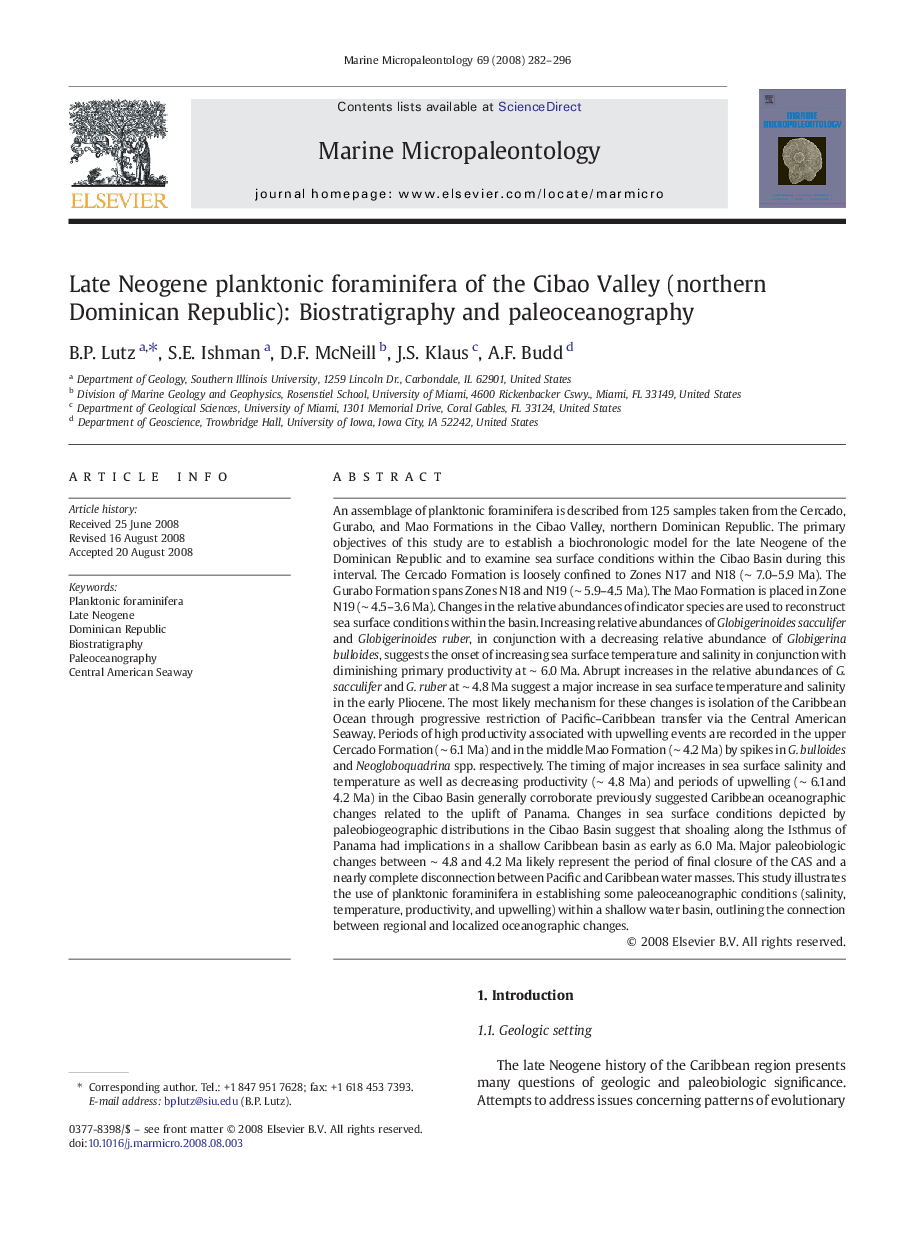| کد مقاله | کد نشریه | سال انتشار | مقاله انگلیسی | نسخه تمام متن |
|---|---|---|---|---|
| 4749328 | 1642219 | 2008 | 15 صفحه PDF | دانلود رایگان |

An assemblage of planktonic foraminifera is described from 125 samples taken from the Cercado, Gurabo, and Mao Formations in the Cibao Valley, northern Dominican Republic. The primary objectives of this study are to establish a biochronologic model for the late Neogene of the Dominican Republic and to examine sea surface conditions within the Cibao Basin during this interval. The Cercado Formation is loosely confined to Zones N17 and N18 (∼ 7.0–5.9 Ma). The Gurabo Formation spans Zones N18 and N19 (∼ 5.9–4.5 Ma). The Mao Formation is placed in Zone N19 (∼ 4.5–3.6 Ma). Changes in the relative abundances of indicator species are used to reconstruct sea surface conditions within the basin. Increasing relative abundances of Globigerinoides sacculifer and Globigerinoides ruber, in conjunction with a decreasing relative abundance of Globigerina bulloides, suggests the onset of increasing sea surface temperature and salinity in conjunction with diminishing primary productivity at ∼ 6.0 Ma. Abrupt increases in the relative abundances of G. sacculifer and G. ruber at ∼ 4.8 Ma suggest a major increase in sea surface temperature and salinity in the early Pliocene. The most likely mechanism for these changes is isolation of the Caribbean Ocean through progressive restriction of Pacific–Caribbean transfer via the Central American Seaway. Periods of high productivity associated with upwelling events are recorded in the upper Cercado Formation (∼ 6.1 Ma) and in the middle Mao Formation (∼ 4.2 Ma) by spikes in G. bulloides and Neogloboquadrina spp. respectively. The timing of major increases in sea surface salinity and temperature as well as decreasing productivity (∼ 4.8 Ma) and periods of upwelling (∼ 6.1and 4.2 Ma) in the Cibao Basin generally corroborate previously suggested Caribbean oceanographic changes related to the uplift of Panama. Changes in sea surface conditions depicted by paleobiogeographic distributions in the Cibao Basin suggest that shoaling along the Isthmus of Panama had implications in a shallow Caribbean basin as early as 6.0 Ma. Major paleobiologic changes between ∼ 4.8 and 4.2 Ma likely represent the period of final closure of the CAS and a nearly complete disconnection between Pacific and Caribbean water masses. This study illustrates the use of planktonic foraminifera in establishing some paleoceanographic conditions (salinity, temperature, productivity, and upwelling) within a shallow water basin, outlining the connection between regional and localized oceanographic changes.
Journal: Marine Micropaleontology - Volume 69, Issues 3–4, December 2008, Pages 282–296